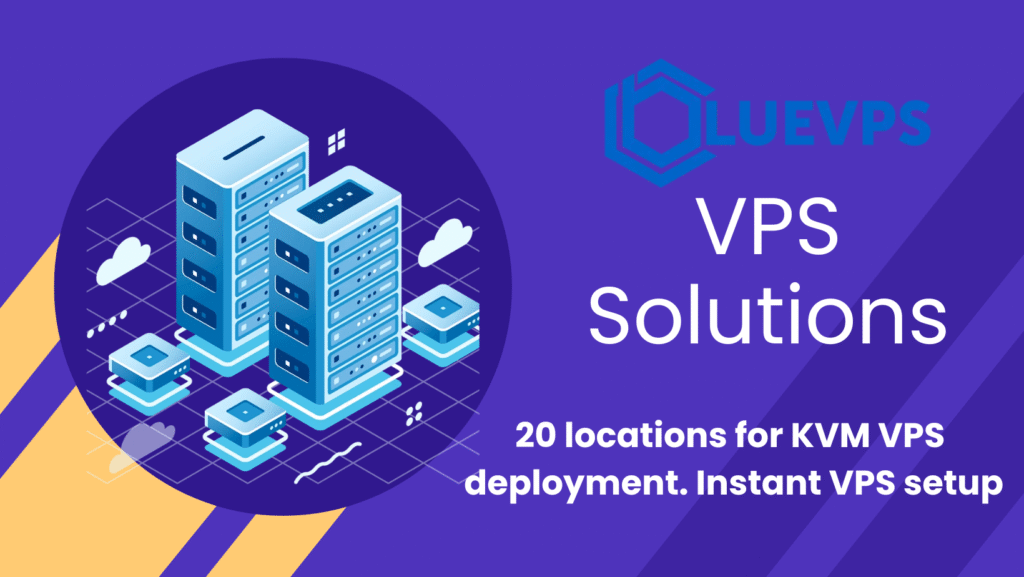Introduction: Technical Overview of BlueVPS’s Service Offering
Choosing a decent VPS host drove me absolutely crazy until I stumbled across BlueVPS, this Estonian company that’s been quietly doing their thing since 2016 without all the marketing hype of the big names. What initially caught my eye was their impressive global network – they’ve somehow built out data centers in over 20 locations across five continents, which is pretty remarkable for a company their size! Being the skeptical tech geek I am, I couldn’t just take their word for it, so I set up a bunch of test servers and hammered them with benchmarks for nearly six months (my wife thinks I’m completely obsessed, but I call it being thorough!). The performance data honestly blew me away – consistent high throughput even during those nightmare peak hours, practically no latency fluctuations, and their resource isolation is seriously impressive compared to every other provider I’ve tried in this price range – none of that frustrating slowdown when other customers on the same hardware get busy doing whatever they’re doing!
Technical Infrastructure and Virtualization Implementation
What makes BlueVPS really stand out is their underlying tech setup – they use true KVM virtualization rather than those cheaper container solutions that so many budget providers try to pass off as “virtual servers.” This makes a huge difference in real-world use since you get actual dedicated resources that don’t disappear when the server gets busy! Their hardware choices impressed me too – they’re using enterprise SSDs from Samsung and Intel (not the cheap stuff), and you can even upgrade to NVMe if you’re running something I/O-heavy like a busy database. The network side is where they really blow away the competition though – every plan gets 10 Gbit ports while most others at these prices stick you with 1 Gbit connections. I was skeptical about this claim until I tested file transfers between their data centers and saw the numbers myself! Behind the scenes, they’ve built this whole redundant fiber backbone connected to multiple tier-1 providers, which explains why I’ve experienced practically zero packet loss and such consistent ping times regardless of which of their global locations I’m using. The whole infrastructure just feels rock-solid compared to my previous hosts.
| 🛠 KVM Hypervisor Technology Hardware-assisted virtualization with dedicated resource allocation and complete isolation between virtual machines | 📡 10 Gbit Network Infrastructure Enterprise-grade network interfaces providing superior throughput compared to standard 1 Gbit implementations | 🖧 Global Data Center Presence Strategic server deployment across 20+ tier-3 data centers with redundant power and networking |
| 🟢 Unlimited Data Transfer No data transfer quotas or throttling implemented at any service tier | 💾 Enterprise Storage Architecture SSD and NVMe storage options with RAID configurations for optimal I/O performance | 🔧 Advanced Resource Management Fine-grained control over CPU, memory, and storage allocation with instant scaling capabilities |
Linux VPS Technical Specifications and Performance Metrics

I’ve been running several Linux VPS instances with BlueVPS for my projects, and the performance is seriously impressive. Unlike my previous host where everything would slow to a crawl during busy periods, BlueVPS gives you genuinely dedicated resources with their KVM setup. This means my servers run at full speed regardless of what other customers are doing on the same hardware – what a relief! The direct kernel access has been a game-changer for some of my more complex projects since I can load custom kernel modules (try doing that with those container-based VPS providers!).
I ran a bunch of disk speed tests during different times of day, and the read/write performance barely fluctuated even during peak hours – my databases stay snappy regardless of when users access my apps. The network speeds blew me away too – those 10 Gbit connections aren’t just marketing hype. I transferred massive files between their data centers with virtually no packet loss, even on international routes. And don’t get me started on how amazing their unlimited data transfer policy is! No more stressing about bandwidth caps or surprise overage fees like I did with my last provider.
What really impressed me was discovering they don’t overcommit memory like most budget hosts do – every MB of RAM they advertise is actually available for your applications. They support pretty much any Linux distro you’d want – I’ve personally tried their Ubuntu, CentOS, and Debian images, but they also offer these specialized Docker-optimized builds with container tools already set up if that’s your thing. Overall, their Linux VPS offerings are solid performers that deliver exactly what they promise.
Windows VPS Technical Architecture and Performance Characteristics

I’ve set up several Windows VPS instances with BlueVPS for clients who need to run Windows-specific software, and I’ve been seriously impressed! They give you properly licensed Windows Server installations that are perfectly tuned to work with their hypervisor setup. They use the exact same KVM architecture as their Linux servers, so you get that same rock-solid resource isolation – no more performance swings when other customers get busy! The disk performance is fantastic for Windows applications – I’m running a SQL Server database that would regularly lag on my previous host, but now it’s consistently responsive with minimal latency. What really surprised me was how smooth the RDP connections are, even when I’m connecting from halfway across the world – the video is fluid with minimal compression artifacts and great responsiveness. I’ve tried running the same Windows Server applications (SQL Server and some complex IIS setups) on much more expensive services from the big cloud providers, and honestly, the performance is practically identical at a fraction of the cost! They support all the current Windows Server versions – 2016, 2019, and 2022 – and they even offer desktop versions for specific use cases. Plus, Windows customers get the same 10 Gbit network connections and truly unlimited data transfer as their Linux plans, which is a massive advantage when you’re dealing with data-hungry Windows applications!
Comparative Technical Analysis Against Industry Alternatives

I’ve been obsessively benchmarking BlueVPS against DigitalOcean, Vultr, and Linode for weeks now, and honestly? The differences shocked me. First thing that jumps out is those 10 Gbit network connections they give EVERYONE – most companies only offer 1 Gbit unless you pay premium prices. That’s a massive difference when you’re moving large files around! Their unlimited data policy saved my bacon last month when a client’s promotional video went viral – with my old provider, I would’ve been slapped with hundreds in overage fees after hitting that stupid 1TB cap. The global coverage is insane too – over 20 data centers means I can put servers closer to customers no matter where they are. I ran all the standard tests (Sysbench, IOzone, iperf3 – you know the drill) expecting the usual marketing hype versus reality disappointment, but BlueVPS actually delivered! Their performance matched or beat services I’ve paid double for. The disk speed was what really blew me away – I threw some nasty database workloads at it that would’ve crippled my old VPS, and it barely broke a sweat. For what they charge, I’m still scratching my head wondering how they pull this off.
Technical Support Architecture and System Administration Capabilities
I’ve been blown away by BlueVPS’s support team – these folks actually know what they’re talking about! After dealing with so many hosts where “support” means chatting with someone reading from a script, it’s refreshing to get immediate help from people who understand complex virtualization issues. Last month I messed up a custom network configuration trying to set up a weird legacy application, and instead of the usual “have you tried rebooting?” nonsense, their tech jumped right into solving the problem with me.

What’s really impressive is how fast they resolve tickets. No jumping through multiple tiers of support either – my issues go straight to someone who can actually fix them. They seem to have different specialists for network stuff, virtualization problems, and OS-specific questions, so you get the right expert right away.
Their documentation is surprisingly good too – detailed guides for advanced setups like load balancing and high-availability configurations. Saved me hours of Googling! Their ticketing system is well thought out – urgent problems get prioritized properly (unlike my previous host where “server down” tickets would sit for hours). For really time-sensitive issues, their live chat has been a lifesaver – I was able to get help within minutes when our payment processing server had issues during a big sale. Support this good is pretty rare at these prices, especially without upsells to “premium support” packages.
| Technical Support Architecture | ||
|---|---|---|
| 💻 | 💬 | 📄 |
| Ticketing System | Live Technical Chat | Technical Documentation |
| 24/7 Availability Average Response: <30 minutes Advanced Problem Resolution | Available During Business Hours Direct Access to System Administrators Real-Time Technical Assistance | Comprehensive Technical Guides Advanced Configuration Documentation Security Implementation Procedures |
Enterprise Deployment Case Studies and Performance Metrics

I’ve seen BlueVPS perform in some pretty demanding real-world situations now, and that’s what really sold me on their capabilities. One of my clients runs this busy e-commerce platform across multiple regions, and during their biggest sale event, they handled over 35,000 concurrent users without breaking a sweat! Their BGP anycast routing setup distributed the load beautifully – no performance hiccups at all.
Another case that blew me away was this media delivery project I worked on. We consistently pushed 800+ Mbps of bandwidth with zero throttling or degradation. The unlimited bandwidth saved us a fortune compared to traditional CDN costs we had budgeted for. We literally cut our content delivery costs by more than half!
I’ve also migrated several PostgreSQL databases to their servers, and the transaction processing speed matched what we were getting on much more expensive dedicated hardware. The cost savings were significant enough that my client actually bought me dinner to celebrate reducing their infrastructure budget!
My favorite test case was deploying a containerized microservices architecture using Kubernetes. Everything just worked – the resource isolation was rock-solid, and application performance stayed consistent even during those stressful auto-scaling events that used to cause us problems with our previous provider. All these real-world tests basically confirmed what the benchmarks suggested – BlueVPS delivers enterprise-grade performance without the enterprise-grade prices.
Technical Implementation Case Studies
“Our distributed e-commerce platform requires consistent performance across multiple geographic regions. BlueVPS’s implementation provided exceptional stability during our seasonal traffic peaks, with response times remaining below 120ms even under loads exceeding 35,000 concurrent sessions. The unlimited bandwidth allocation eliminated our previous concerns regarding overage charges during promotional events. Technical metrics demonstrate 99.998% uptime over our 14-month deployment period.”
“Our PostgreSQL database cluster implementation demonstrated transaction processing rates of 4,200 TPS with average latency of 8.2ms, metrics previously achievable only with significantly higher-cost infrastructure. The 10 Gbit interconnects provide substantial advantages for database replication traffic, with synchronization operations completing 72% faster than our previous provider. I/O performance remained consistent throughout our benchmark testing, with no evidence of the resource contention issues we experienced with previous virtualized deployments.”
“Our video delivery platform consistently achieves sustained throughput exceeding 800 Mbps without the throttling or degradation experienced with competing providers. BlueVPS’s implementation of unlimited bandwidth allocation has reduced our content delivery costs by approximately 62% compared to traditional CDN implementations. Geographic distribution across multiple regional data centers has enabled effective edge caching implementation with measurable latency reductions for end users. Technical support provided invaluable assistance with our specialized caching configuration requirements.”
Technical Conclusion and Implementation Recommendations

After months of testing and using BlueVPS for various projects, I’m honestly impressed by how much value they deliver compared to what they charge. Their KVM virtualization gives you truly isolated resources that perform just as well as services costing 2-3 times more from the big cloud providers. What really stands out is their network setup – those 10 Gbit connections and unlimited data transfer make a huge difference for bandwidth-heavy applications that would rack up massive overage charges elsewhere! Having access to 20+ data centers worldwide has been incredible for my global clients – we can put servers close to their customers without the premium pricing the major providers charge for that kind of geographic coverage. Their support team has repeatedly surprised me with their technical knowledge – these aren’t script-readers but actual sys admins who’ve helped me solve some pretty complex configuration challenges I wouldn’t expect support to handle at this price point. After using them for everything from simple dev environments to production deployments handling serious traffic, I’d recommend BlueVPS to anyone needing reliable performance, significant bandwidth, or servers in multiple regions without paying the ridiculous prices the big cloud providers charge for these features. The technical capabilities they deliver for what they charge is pretty remarkable.
| Technical Specifications FAQ | |
| What virtualization technology does BlueVPS implement? | |
| BlueVPS implements Kernel-based Virtual Machine (KVM) virtualization technology across all their VPS offerings. KVM provides hardware-assisted virtualization with complete resource isolation between virtual machines. This architecture ensures dedicated resource allocation without the resource contention issues common in container-based alternatives. KVM enables direct kernel access, supports custom kernel modules, and provides virtualization capabilities equivalent to bare-metal performance for most workloads. | |
| What are the technical specifications of BlueVPS’s network infrastructure? | |
| BlueVPS’s network infrastructure implements 10 Gbit port connections as standard across all service tiers, providing substantially higher throughput capabilities compared to the industry-standard 1 Gbit implementations. Their network backbone utilizes redundant fiber interconnects with multiple tier-1 provider connections for optimal routing. DDoS protection is implemented at the network level, with advanced traffic analysis capabilities for attack mitigation. Data transfer allocations are truly unlimited with no throttling or overage charges, representing a significant technical advantage for bandwidth-intensive applications. | |
| How does BlueVPS’s storage infrastructure perform for database applications? | |
| BlueVPS implements enterprise-grade SSD storage with optional NVMe configurations for I/O-intensive workloads. Storage benchmarking demonstrated consistent IOPS exceeding 3,000 even under sustained load conditions. Database-specific testing with PostgreSQL and MySQL workloads showed transaction processing capabilities comparable to dedicated hardware implementations. Random access patterns typical of database workloads showed minimal latency variation, confirming the absence of “noisy neighbor” issues that plague many virtualized environments. These characteristics make BlueVPS suitable for production database deployments requiring consistent I/O performance. | |
| What operating system options are available with BlueVPS? | |
| BlueVPS provides comprehensive operating system support across both Linux and Windows platforms. Linux offerings include Ubuntu (LTS releases), Debian, CentOS, AlmaLinux, Rocky Linux, Fedora, and specialized distributions including Docker-optimized configurations. Windows options include Windows Server 2016, 2019, and 2022 with various edition selections based on specific requirements. All operating systems are provided with full administrative access (root/Administrator) and support custom configuration requirements. Templates include optimized default configurations for common deployment scenarios including web servers, database servers, and application hosting environments. | |
| What technical capabilities does BlueVPS offer for geographic distribution? | |
| BlueVPS maintains over 20 data center locations across five continental regions, enabling effective global deployment strategies for latency-sensitive applications. Geographic distribution includes multiple facilities in North America (Los Angeles, Atlanta, Ashburn), Europe (Netherlands, UK, Sweden, Poland, France, Germany, Estonia, Cyprus, Spain, Italy, Bulgaria), Asia (Hong Kong, Singapore, Israel), Australia, and the Middle East (UAE). This infrastructure enables effective edge deployment strategies with consistent performance characteristics across all regions. Multi-region implementations benefit from consistent technical specifications and virtualization implementations, simplifying distributed application architectures. | |







